Posted: December 15th, 2014 | Author: Nathan | Filed under: found sound objects, music, sound design
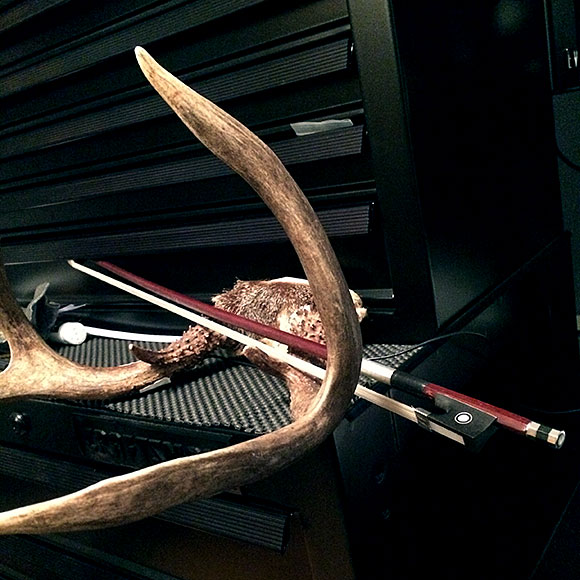
Most years I host a “white elephant” party: Bring gifts you were given that are pretty bad, re-wrap them, and then you pick from the pile and laugh at the bizarre stuff you unwrap. Last year, I wound up with a pair of deer antlers.
I don’t hunt, yet I have a thing for taxidermy. I have no idea why.
As they sat in my studio, I thought back to an interview I did with Cheryl Leonard for the Sonic Terrain blog a few years ago. I remember her making instruments from limpet shells and other organic objects. Why was I not exploring the sonic possibilities of this strange object on my shelf?
Deer antlers are bone, not hair, so they are riddled with hollow channels, and are extremely tough. The main thing I tried was to explore their resonance, with a cello bow. I had to lay a good amount of rosin on the bow, but they did resonate. The sound is hissy, atonal, but with some pronounced fundamentals and overtones…just not in relationships that one usually considers musical. I used a Barcus Berry 4000 contact microphone and recorded onto a Sound Devices 702 field recorder.
When I hear an interesting sustained sound with too many frequencies, or odd frequency relationships, I usually go to one place to create something musical out of it: iZotope Iris. It’s a very creative tool for making playable virtual instruments out of pretty much any sound. In this case I also used New Sonic Arts’ Granite granular synthesis plugin for several layers. It all sounded very breath-y, like a somewhat melodic whisper. I mixed it with some LFO-driven rhythms in Reason and a bassline and drone from Madrona Labs’ Aalto. It was all put together in Logic Pro X with very few effects, lightly compressed by Cytomic’s The Glue.
Deer antlers, even processed through modern software, aren’t the most flexible or sonically soothing instruments around, but this article can at least serve as a reminder to explore everything around us for its interesting sonic possibilities. You never know what you’ll find.
[soundcloud url=”https://api.soundcloud.com/tracks/181708958″ params=”color=ff5500&auto_play=false&hide_related=false&show_comments=true&show_user=true&show_reposts=false” width=”100%” height=”166″ iframe=”true” /]
Tags: ambient, drone, found object, music, music 2014, resonance | No Comments »
Posted: November 26th, 2014 | Author: Nathan | Filed under: music, sound design, synthesis

Letting my fingers do the walking, and talking, in Samplr for iOS.
A while back, Sonic State did a neat profile of Alessandro Cortini’s live synth setup for Nine Inch Nails, in which he described his use of a four-track cassette player as a mellotron. He’d record many, many repeating loops, one loop per track, and then use the mixing faders to fly out certain chords or drones. Pretty fun use of old technology.
In playing around with Samplr for iOS, it struck me that it could behave like a mellotron of sorts, too. Sure, Samplr (and other similar apps, like Curtis, csSpectral, and Sector) is great for mashing stuff up in an extreme way, but I decided if I could play it a bit more like a piano.
Since Samplr only slices samples into increments of four, I output a little more than two scales of a synth sound in G# minor. Then it was a simple as loading that sample in, selecting 16 slices, and then playing Samplr as a keyboard.
The results were odd, glitchy, loose, and interesting. I liked that I could hold chords while also dialing in reverb, delay, even playback loop length. The loop points were obvious, but at the right lengths and tempos, they can become rhythmic or simply textural. When playing single melodies, possible by dragging my finger between slices simulated piano runs. Then, inspired by Mr. Cortini’s solo albums, I decided to make a track with samples just from one single synth, played back from Samplr.
Today’s audio clip features a live recording in multiple passes. All of the sounds are from the TAL Bassline101, an amazing emulator of the Roland SH101. I output only two audio files, each with a unique patch but in the same pitch range and scale, and the rest of the variations are from Samplr.
[soundcloud url=”https://api.soundcloud.com/tracks/178303998″ params=”color=ff5500&auto_play=false&hide_related=false&show_comments=true&show_user=true&show_reposts=false” width=”100%” height=”166″ iframe=”true” /]
Tags: iPad, music, music 2014, software | No Comments »
Posted: October 1st, 2014 | Author: Nathan | Filed under: gear, music, sound design, synthesis

Hand-built for drone-y aggression.
I love handmade soundmaking devices, but outside of my beloved Grendel Drone Commander, a lot of the weird noise boxes and effects I have are, well, noisy. They tend to be aggressive, loud, and blippy. Some accept MIDI, some accept CV, some accept no sync signal at all.
One evening I wondered if I could coax them into some semblance of ambient drones, to loosen myself up and not record to a fixed tempo, and to not get too “precious” with editing in post. Somehow the angry nature of these devices just seems to bleed through anyway. Or is that my angry nature?
So, the result of this cathartic experiment was “angry ambient.” Or, angrient.
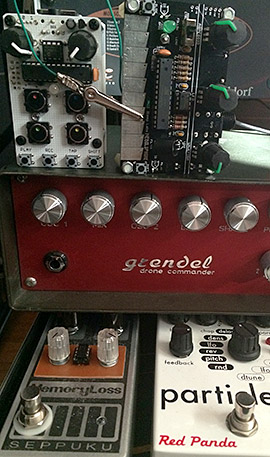
This track features the following:
- All takes recorded live into Logic Pro X: No sync to anything, no MIDI, no CV.
- One track of a Bleep Labs Nebulophone, with its alligator clip clamped onto a key for a sustained drone, recorded through a Red Panda Particle pedal set to Reverse, both tweaked live. The dry and effected track were tracked simultaneously.
- Another droned Nebulophone track went through the Particle set to Delay, and then through a Seppuku Memory Loss pedal, with its clean microchip inserted, all three tweaked live. The dry and effected track were tracked simultaneously.
- One track of the RareWaves Grendel Drone Commander, recorded 100% dry. That thing needs no love, especially when its bandpass filters gets overdriven at low frequencies. Yummy.
- One track of the Bleep Labs Bleep Drum, played live in Noise mode, but then run through Glitchmachines’ Fracture plugin first, and the Michael Norris Spectral Partial Glide filter. That’s what generates the bright, granulated shimmers. These are the only digital effects plugins on any channel.
- Volume automation was done in one pass, “live.”
- The whole thing is run through U-He’s Satin tape emulator plugin for some additional harmonics and mid-high sweetening.
It is what it is.
[soundcloud url=”https://api.soundcloud.com/tracks/168600426″ params=”color=ff5500&auto_play=false&hide_related=false&show_comments=true&show_user=true&show_reposts=false” width=”100%” height=”166″ iframe=”true” /]
Tags: audio equipment, drone, experimental, music 2014, sound design | No Comments »
Posted: September 25th, 2014 | Author: Nathan | Filed under: music, sound design

Les Paul clone, eBow, and chopsticks on a foggy Saturday morning.
This spring I rediscovered the guitar, first as a compositional tool – my music’s texture is so different when I start with the guitar and not keyboards – and soon thereafter as a tool for sound design. I started getting back into prepared guitar and extended playing techniques, and rekindled my love for vibrating steel.
In fact, the more I did it, the fewer processors and effects I used. It was weird enough already. And I like weird. It led me on a whole summer-long journey into music, as opposed to field recording or sound design, often on the cinematic tip. This fall I may share some more results of this summer’s studio musicfest.
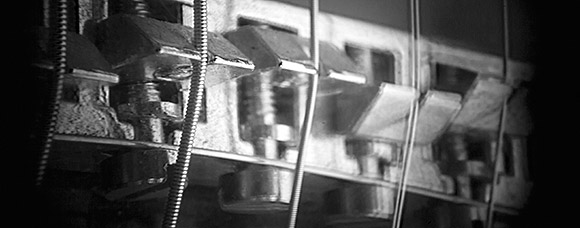
Steel is real.
Today’s sound is more drone than music, though. It’s from a live improvisation session featuring my old Epiphone Les Paul clone, an eBow, and two chopsticks stuck in the strings at the 12th fret.I also took some small alligator clips, clipped them to some strings, and flicked them against nearby strings for some filigree panned to the left and right.
No effects were used (distortion is just from the preamp) except some cutting with a low shelf EQ and a slight, broad EQ lift around 2KHz; no compression, either. The whole session has been only slightly edited in post.
Headphones and a dim room recommended.
[soundcloud url=”https://api.soundcloud.com/tracks/168600067″ params=”color=ff5500&auto_play=false&hide_related=false&show_comments=true&show_user=true&show_reposts=false” width=”100%” height=”166″ iframe=”true” /]
Tags: drone, guitar, music 2014 | No Comments »
Posted: June 25th, 2014 | Author: Nathan | Filed under: gear, music, sound design
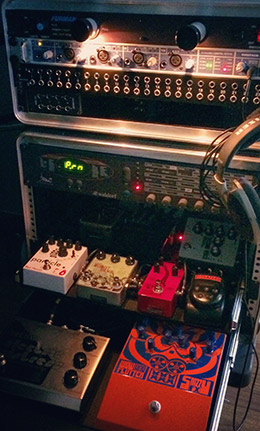
I favor discrete effects loops on rackmounted shelves, since I’m not a stomping-on-stage kind of guy.
As evidenced by a few recent posts here on Noise Jockey, I think the most exciting way to use guitar-oriented effects pedals is thinking of them as modular synthesizer units. (Indeed, it’s no accident that many boutique pedal makers are now issuing Eurorack versions of their stompboxes.) My workflow usually involves recording signals dry, then running them through the effects as sends. This gives me maximum control when composing, designing, and mixing. I keep my pedals in two distinct loops: One for sculpting and distorting tone, and one for filtering and modulation.
However, just sending signals out to pedals as effect sends from an audio interface doesn’t always work very well. Most effect pedals expect guitars at their front door, not synths, virtual instruments, samples, or field recordings. Most guitars with passive pickups, of course, are high-impedance instrument-level signals, not low-impedance line-level signals that one would expect from hardware synths, virtual instruments, or pre-recorded tracks that are coming back out via an audio interface. This can mean that the effect return might be extremely low, distorted, or noisy/hissy, depending on the signal and what specific pedals are in the effects chain.
So, there are basically two ways to address this problem.
- Use pedals that natively support line-level signals. This usually leads one to higher-end pedals like the Moogerfoogers, and they can be expensive. Rackmount multi-effect units often handle line inputs just fine, but many of those units are also expensive and, in my experience, lack the character and flexibility of a more modular approach of individual pedals. My bigger issue with this approach is that it seems silly to limit one’s creativity based on the vagaries of electrical engineering.
- Use a device in the effects chain to properly match impedances of the sent signal to the effects in the chain. This approach gives the designer, artist, musician, or engineer the best balance of creative freedom while correct managing signal level to optimize frequency response, gain, and noise levels.
DI (direct injection) boxes won’t solve this problem, since they usually output at microphone level – still a high impedance signal. No, dear friends, what you really want is a re-amping device, a box that takes any pre-recorded signal and sends it to a guitar amp or effects chain as a high impedance signal. These are as expensive as decent effect pedals themselves, but worth their weight in gold to treat your audio right and send any signal to any effect. A most egalitarian piece of electronic equipment. Many reamp devices exist, even as 500 series modules!
But remember my two-loop effects chain? Ostensibly I’d need a re-amp on each chain; that sounded expensive. Or so I thought, until I discovered the Pigtronix Keymaster.
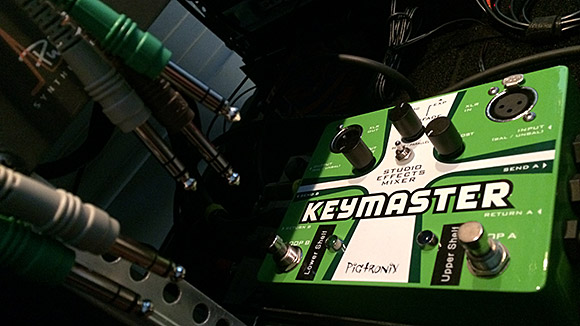
There is no impedance, only Zuul.
Besides the obvious bonus of being named after a Ghostbusters reference, the Keymaster has two dedicated re-amping loops, each with a send and return and individual loop output gain knobs. PERFECT. Heck, it even sports XLR I/O for the fancy lads and lasses. As an added weird bonus, it actually has a crossfader between each loop, should one want to switch between the two in real time. While I have used this myself musically, most of the time this large green and white box stays in the back of my effects back near my  power supply, silently channeling and impedance-matching my dry signals into mangled layers of noisy glory.
Many other re-amping boxes exist, and single-channel units are cheaper, but for maximum creative weirdness and flexibility, the Keymaster has become the core of my externalized sound design and musical effects chain, even when it’s simply a silent partner in making noisy things happen. Heck, it even  lets me run them in serial or parallel, and freed up some I/O plugs on my patchbay and audio interface.
So, if you’re interested in experimenting with effects pedals and stomp boxes as external effects devices, grab a re-amping box and hit eBay or your local guitar shop in search of fun stompboxy goodness. We’re in a golden era of boutique audio hardware creation, so there’s no better time to experiment with literally out-of-the-box noisemaking.
Today’s sound is an extremely simple drum loop, but using a bunch of effect pedals, all managed through the Keymaster. First you’ll hear a rhythmic start with just a Dwarfcraft Robot Devil pedal, with only its starved circuit creating the rhythm, being run through a Red Panda Particle pedal set on delay. Then you’ll hear a hi-hat run through a Snazzy FX Wow and Flutter pedal. A dry kick drum then starts, and the snare eventually gets the Red Panda Particle treatment as a super-wet granular delay.
[soundcloud url=”https://api.soundcloud.com/tracks/152340481″ params=”color=ff5500&auto_play=false&hide_related=false&show_artwork=false&show_comments=true&show_user=true&show_reposts=false” width=”100%” height=”166″ iframe=”true” /]
| 12 Comments »
Posted: May 6th, 2014 | Author: Nathan | Filed under: gear, music, sound design, synthesis
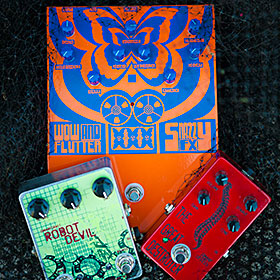
Sometimes sound design requires thinking inside of multiple boxes.
I’ve developed a small collection of handmade and boutique electronic effects and instruments over the years, like the Grendel Drone Commander, Lite2 Sound PX, and many more (perhaps the subject of another post). Longtime readers may recall that I just love supporting independent makers and small cottage industries: That’s where all the weird, truly innovative stuff happens, and I (like many of you, dear readers) am more interested in cool sound design possibilities than straight-up distorted guitarrrrrrrr sounds.
Beyond this, I’ve also been expanding my collection of effects pedals. My latest three are definitely the weirdest: The Great Destroyer and Robot Devil from Dwarfcraft Devices, and the Wow & Flutter from Snazzy FX.
Read the rest of this entry »
Tags: effect pedal, sci-fi, sound design, sound effects | No Comments »
Posted: April 2nd, 2014 | Author: Nathan | Filed under: field recording, gear, sound design
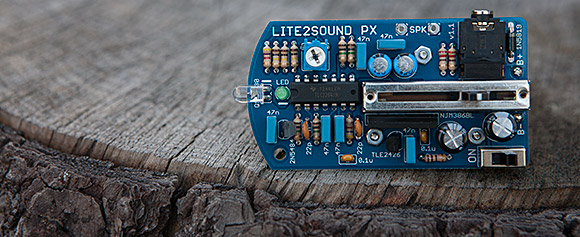
Rare Waves’ Lite2Sound PX, by Eric Archer: A photonic microphone!
I’ve previously written about the heavily-built, wickedly cool Grendel Drone Commander synth from Eric Archer. I check his site, Rare Waves, from time to time for new handmade electronic toys, and I was really intrigued by his newer Lite2Sound PX unit. This small device, in Eric’s words, “extracts audio from ambient light.” It’s a photodiode amplifier. Or a photosensitive microphone. Point it at light, it makes sound. It runs off a 9-volt battery, has a volume control, and a headphone jack. Simple, exciting, and a whole new world of sonic insanity. You can buy them as kits or, as I did, fully assembled.
Sounds pretty straightforward. If you just point it at bright, broad light sources, it’s kind of disappointing. It’s when you start listening to artificial lights in otherwise dim environments that some serious magic starts to happen. My experiments were conducted in and around high tech computer equipment, running an 1/8″ mini jack from the headphone output into my Sony PCM -D50 recorder.
Lights inside of PCs, modulated by fans…and further modulated by speaker grills as I passed the Lite2Sound from side to side. Ethernet network activity lights. Server disk access indicator lights. A close up of the power button of an XBox 360 while booting up. Pulsing lights of devices in standby mode. Halogen lamps behind spinning desk fans.
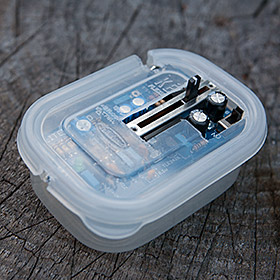
Lightly armored for future fieldwork!
The resulting sounds were astounding in their range: Static, glitches, distorted synth pads, pure sinewave tones, sawtooth-like tones, and much more. You can’t control it, really. It’s a tool of discovery, and its very nature encourages constant experimentation. It was so small and so perfectly complemented a handheld field recorder, I just wanted to take it everywhere and point it at everything! It imparted the same joy as when you start recording with contact microphones, or hydrophones: A new way to listen to the world around you. The more I used the Lite2Sound, I put it in a small plastic container (hacked with an XActo knife for access to controls and the headphone jack) in order to keep the components better protected.
Lite2Sound is a pretty narrowly-focused device and how useful it is to you depends on your taste for the unpredictable. Me, I adore this thing. Hell, I bought two (for future stereo photo-phonic insanity). It encourages constant experimentation, weighs nothing, and I can see using its output in both sound design and musical contexts. Eric Archer nails it again with an odd concept and a rock-solid, focused execution that results in a toy that just begs to be played with.
[soundcloud url=”https://api.soundcloud.com/tracks/139812053″ params=”color=ff5500&auto_play=false&hide_related=false&show_artwork=false” width=”100%” height=”166″ iframe=”true” /]
Tags: audio equipment, digital audio, field recording, sound design, sound effects | 3 Comments »
Posted: May 16th, 2013 | Author: Nathan | Filed under: found sound objects, sound design
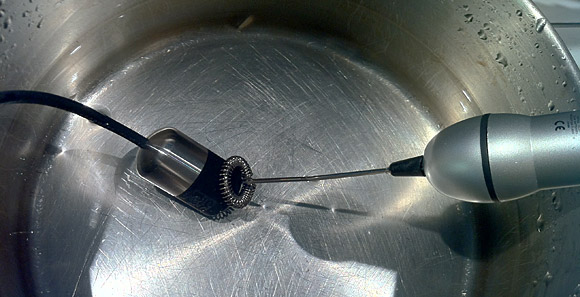
This thing was given to me as a Christmas gift. I immediately wanted to not froth milk with it, but to record it. With a hydrophone.
It was initially disappointing…until I put it into a metal pan and realized that its interaction with the pan, not the water, was far more interesting. The hydrophone was still in the water, but the frother was used in the water, inside the pan, and outside the pan as well, at varying speeds.
[soundcloud url=”http://api.soundcloud.com/tracks/73914784″ params=”auto_play=false&show_artwork=false&color=ee0000″ width=”100%” height=”166″ iframe=”true” /]
[Aquarian Audio H2a-XLR hydrophone into Sound Devices 702 recorder]
Tags: hydrophone, metal, sound design, sound effects | No Comments »
Posted: December 2nd, 2012 | Author: Nathan | Filed under: field recording, nature recording, sound design
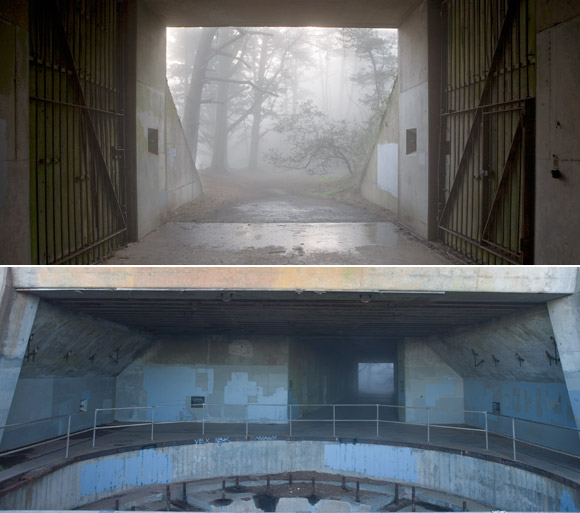
“Construction 129,” a never-completed gun emplacement overlooking the entrance of the Golden Gate, Fort Cronkhite, Marin Headlands, California.
When a winter storm was forecast for the San Francisco Bay Area, I decided to head to the Marin Headlands and try my luck recording bad weather in the abandoned gun emplacements and military fortifications of Fort Cronkhite. I had previously found some great metal sounds at Fort Baker, also in the Headlands, and I was also inspired by Tim Prebble’s high-wind-sub-bass-generator post.
Unfortunately for me, the storm track was slower than predicted, and I wasn’t able to record in peak wind, although some moderate rain started to fall. Such things happen, even with the best of intentions. So, what do you do when your primary plan doesn’t pan out? You reset your expectations and record what you can. I mean, c’mon, I’m in these amazingly evocative ruins! Surely there’s something that’s audibly interesting!
So, I decided to record rain in the tunnels. A recent re-viewing of Ridley Scott’s Prometheus reminded me that tunnels and caverns in films often feature water drops that are drenched in heavy reverb. I pressed the “record” button in several settings and closed my eyes: Was I in the bowels of an ancient spacecraft? The Mines of Moria? The hull of a leaky, empty freighter?
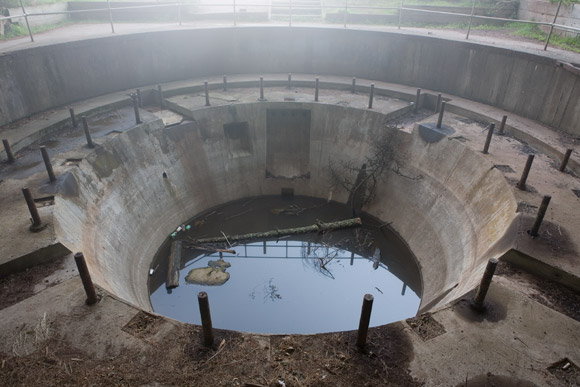
The gun emplacement at Construction 129. No weapon was ever installed.
Occasional wind blasts forced me to enable a high pass filter at 120Hz to try to remove some of the ambient rumble that didn’t help the recording. In addition, there are no fewer than three foghorns in the Marin Headlands, so I had to make an edit every 50 seconds to eliminate the lonely bleat of the Point Bonita lighthouse horn.
There is always something worth recording. You just need to let your disappointment go, reset your expectations with some beginner’s mind, and just start rolling.
[soundcloud url=”http://api.soundcloud.com/tracks/69735256″ params=”auto_play=false&show_artwork=false&color=ee0000″ width=”100%” height=”166″ iframe=”true” /]
[Sennheiser MKH 30/50 mid-side stereo pair into Sound Devices 702 recorder]
Tags: field recording, nature recording, rain, ruins, sound design, sound effects, tunnel, water | 2 Comments »
Posted: November 12th, 2012 | Author: Nathan | Filed under: field recording, sound design

The Uptown, Mission District, San Francisco. Photo source unknown.
The Uptown is the closest bar to my office, and is a classic Mission District hipster dive bar. One hot, Indian Summer day in the fall, it was filled with patrons, windows flung open…but the jukebox was off. And everyone was concentrated by the bar and front door, leaving the back area empty.
Anyone who tries to record diffuse crowd sounds, or “walla,” knows that this is a golden moment. Human voices, but little intelligible conversation, no background music, not too far away from the noise source. I ordered a beer, sat as far away from everyone as I could, and started rolling on my handheld recorder.
I did a little trickery by taking a segment of the recording, swapping the left and right channels, and layering it with another segment, to effectively double the number of people in the room. Luckily there wasn’t too much background noise to also get multiplied. Perhaps not the most interesting of moments on its own, but the little details of the cash register ring, squeaky door hinges, and the general density of the human sounds represents (to me, anyway) a surprisingly hard-to-capture scene without the intrusion of music.
[soundcloud url=”http://api.soundcloud.com/tracks/37831942″ params=”auto_play=false&show_artwork=false&color=ee0000″ width=”100%” height=”166″ iframe=”true” /]
[Sony PCM-D50 recorder, capsules at 120°]
Tags: ambience, sound design, sound effects, urban, voice | No Comments »














